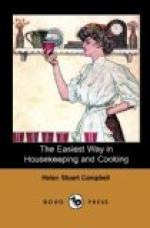Oatmeal may take rank as one of the best and most digestible forms of farinaceous food. Some twenty-eight per cent of the grain is husk, seventy-two being kernel; and this kernel forms a meal containing twelve parts of nitrogenous matter, sixty-three of carbo-hydrates, five and a half of fatty matter, three of saline, and fifteen of water. So little gluten is found, that the flour of oats can not be made into loaves of bread; although, mixed and baked as thin cakes, it forms a large part of the Scotchman’s food. It requires thorough cooking, and is then slightly laxative and very easily digested.
Buckwheat is very rich in nitrogenous substances, and as we eat it, in the form of cakes with butter and sirup, so heating a food, as to be only suitable for hard workers in cold weather.
Indian corn has also a very small proportion of gluten, and thus makes a bread which crumbles too readily. But it is the favorite form of bread, not only for South and West in our own country, but in Spanish America, Southern Europe, Germany, and Ireland. It contains a larger amount of fatty matter than any other grain, this making it a necessity in fattening animals. In a hundred parts are eleven of nitrogen, sixty-five of carbo-hydrates, eight of fatty matter, one and a half of saline, and fourteen of water. The large amount of fatty matter makes it difficult to keep much meal on hand, as it grows rancid and breeds worms; and it is best that it should be ground in small quantities as required.
Rice abounds in starch. In a hundred parts are found seven and a half of nitrogen, eighty-eight of starch, one of dextrine, eight-tenths of fatty matter, one of cellulose, and nine-tenths of mineral matter. Taken alone it can not be called a nutritive food; but eaten with butter or milk and eggs, or as by the East Indians in curry, it holds an important place.
We come now to OLEAGINOUS SEEDS; nuts, the cocoanut, almonds, &c, coming under this head. While they are rich in oil, this very fact makes them indigestible, and they should be eaten sparingly.
Olive-oil must find mention here. No fat of either the animal or vegetable kingdom surpasses this in delicacy and purity. Palm-oil fills its place with the Asiatics in part; but the olive has no peer in this respect, and we lose greatly in our general distaste for this form of food. The liking for it should be encouraged as decidedly as the liking for butter. It is less heating, more soothing to the tissues, and from childhood to old age its liberal use prevents many forms of disease, as well as equalizes digestion in general.




